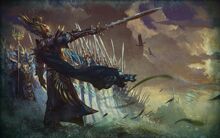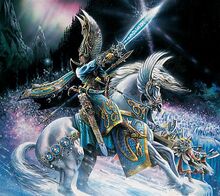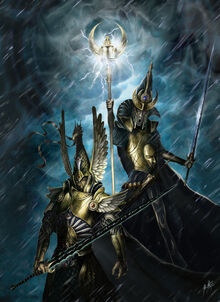"We are the chosen of Corellon, beloved of the Seldarine and heirs to Arvandor. Our armies are the finest in creation; swift where our foes are lumbering, cultured where they are barbaric. Give no thought to failure, nor defeat – we are the Children of Sehanine and we shall prevail." -Shanairra

Origins[]
Homeland: Feywild
Adopted Homeland: Eternia
Folk[]
The Eladrin are tall, fair and slender in comparison to humans. They are almost physically flawless and rarely succumb to disease or mutation, and can live for hundreds, even thousands of years. They are usually seen as being arrogant, aloof, and overly concerned with beauty and art; a reputation which is not completely unfounded, for in return they generally view themselves as being superior to other races. Eladrin are a conservative warrior-aristocracy society with a deep understanding of magic and a highly developed arcane tradition.

The Eladrin psyche is both mystical and logical - a near perfect balance between the two. They have a strong influence of seeing the duality of things, and refuse to limit themselves to any one-sided view of things. They have a male and a female ruler, and the very characters in their language cannot mean one single thing, but represent many. Eladrin can be seen as emotional creatures, perceived by some as empathetic, as well as passionate about their chosen pursuits. Even so, they can also be rash when angered, and many Eladrin have a temper about them, with a great dislike to being wrong. They are extremely focused beings, and it is rumored that Eladrin may look at a painting for what seems to have been a single moment, and become so intrigued in every little detail of it, that they will lose track of time and a year will have passed after they finish. Even such interesting topics could take a thousand years to fully contemplate. With their exceptionally long life spans, in comparison to other mortals and even other fey, time is less important. Eladrin also have a great love of intrigue – they are a political race, and do enjoy the aspects of this quality to the fullest.
Highly adept in the schools of magic, arcana suffuses their everyday lives. Though it is not regarded as the only solution, it is used to improve the quality of nearly everything. For example, arcana will be used to strengthen the integrity of a building, and wards will protect it, as seen with the High Tower. They might also use it to execute the tedious tasks of life, such as sending messages. If it is indeed dire enough, Eladrin are not unknown to open portals to hasten letters to their destinations. This practice of lessening the stresses of life is particularly used by mages. As a race, Eladrin are extremely proud of their fey heritage, and make a concerted effort to maintain their lineage. Their name translates from the Elven language as 'high elves' or 'children of noble birth.' For their part, the Eladrin argue that they are the most civilized race, an argument that even human scholars find difficult to refute.

House soldiers signify themselves with banners from their house, while the city army carries the banner of the city. This is done so that each house could claim credit if there are benefits to be won after the war. Each army has its own chain of command, which is headed by an eladrin noble such as a Bralani or Ghaele. This means that an eladrin force is actually made up of several armies in addition to the city army. The leaders of each army still convene with one another to plan their strategies as an alliance, but retain their respective command structures on the field. The standard infantry is called a Fey Knight, while a mage is called a Twilight Incanter. Houses also deploy fellowships of highly trained and specialized warriors of their house to the field. The Shining Guard, Dragon Princes, and Phoenix Guard, are all highly efficient outside the formal struture of organized armies. Such groups are a combination of various skills provided by each warrior. It is said that providing a fellowship is the equivalent of providing one hundred Fey Knights. The usage of fellowship tactics has turned the tides of battles in the long line of Eladrin wars.
History[]
First Era[]
In the earliest days of the feywild, the elves of noble birth were divided simply between the moon elves and the sun elves. The moon elves, also known as silver elves, gray elves, and qualinesti, enjoyed learning secrets and pulling pranks on the other fey. They led lives in pursuit of gossip, diversions, and amusing intrigues. Petty and vain, they were like petulant children at play. They loved to have fun, to revel in eternal twilight, and to follow their whims.

But they could also be carelessly cruel, capricious, and vindictive. It is thought that they did not dream, which would explain why they spent so much time harvesting the dreams of others. They distilled these stolen dreams into sparkling energy that they carried around with them. The amount of dream-stuff harvested represented a significant amount of magical power when collected over time.
The sun elves, also called the sunrise elves, gold elves, valley elves, and silvanesti, were aristocratic, ruthless, and predatory. Their society revolved around the laws of beauty, a code that specified how one's cunning and personal attractiveness determined one's social rank. If one was only moderately beautiful, they would be a low-ranking elf. If they were ugly or disfigured - or a non-elf, which is by definition a truly ugly thing to be - then they were an eyeblight, a creature unworthy of respect or even, if it is deemed so, life.
There were four official ranks of elves, determined by measure of beauty, and the non-rank of eyeblight for everyone else. Any elf who possessed the minimum threshold of beauty and grace was granted the title of faultless. Dignitaries, higher-level functionaries, and other important people among the elves attained the rank of immaculate. Packmasters and important courtiers were of the exquisite rank, and they had the privilege of being able to speak directly to perfects. The perfect were elves so beautiful and so shrewd that they ruled all other elves, and there were only a few of these in the feywild.
Second Era[]
It is unknown when, precisely, the twin sisters Titania and Mab rose to power. Only that the archfey, and the fey lords themselves, were still young when the queen of summer united the wayward sun elves, now called green elves and the coral court, first convening her seelie court, and the queen of air and darkness first united the divided moon elves, now known as gloaming elves and winter elves, first convening her unseelie court.

People tend to think of fey as lovely creatures of almost unearthly beauty and grace. This image epitomizes the fey of the seelie court. Many artists and bards, both fey and other, have striven to capture the beauty of the seelie court. Most have gone mad; none have truly succeeded. Pure manifestations of nature and beauty, the members of the seelie court viewed themselves as the pinnacle of perfection. This elitist attitude restricted status in the court to only pure-blood fey. A court fey could trace his or her lineage back several millennia, showing nothing but true fey.
Fey high society and the fey realms contained the only creatures whose opinions mattered. Politics thrived in this elitist environment. Seelie fey formed cliques and opposed one another. In the endlessly politicking and gossiping world of the seelie court, status could be won by hosting guests - willing or unwilling - or attracting followers with great skill in a craft or performance art. Seelie court fey occasionally tolerated the company of beautiful or gifted creatures, preferring those of fey or celestial blood. These "court friends" provided companionship and amusements, but only those with pure lineage held positions of importance.
Admittance to the seelie court for outsiders was extremely rare, even more so if the outsiders were not of pure fey blood. Upon entrance to the court, visitors presented valuable and unusual gifts for the queen of summer, lest they find themselves lost in an endless hedge maze. Suitable gifts for the queen included figurines of wondrous power, gems of brightness, and magical jewelry. The throne itself, and the queen who sat on it, were the focal points of the room. The throne of the seelie court was shaped like a large ice dragon, as brilliantly cold and glittery as the fey nobility.
Titania, queen of summer, and king Oberon, were the rulers of the seelie court. An undisputed beauty, Titania looked unfavorably upon female courtier or visitors whose appearance rivaled hers. This attitude was caused, in part, by the occasional wanderings of King Oberon's affection.

Unlike the selective, restrictive seelie court, the unseelie court welcomed anyone and everything with even a drop of ancestral fey blood. Fey could and did breed with anything, creating odd, mixed creatures. Most species considered the offspring grotesque monsters. The mutant creatures gravitated towards the unseelie court, which welcomed them and gave them an environment where peculiar physiologies and abilities were the norm.
The unseelie court was a more hospitable place for non-fey as well. Court nobles eagerly provided patronage for creatures who were extremely strong, dexterous, clever, beautiful, or talented. Obtaining the sponsorship of a court noble was not without its rewards, nor without its dangers. For instance, a gifted bard whose playing impressed a fey nobleman would be invited to his castle as a guest. Once there, the bard would be feted and asked to play every night - and never be permitted to leave.
Ruling over all these oddities was the Queen of Air and Darkness: a fey of unsurpassed beauty and grace. The Queen of Air and Darkness had no consort and no surviving children. The court was rife with gossip and political maneuvering as each noble curried the queen's favor in the hopes of being named her heir. Outsiders not of fey blood were rarely admitted to the unseelie court. Visitors presented unusual and powerful gifts for the queen, or they would find themselves the quarry of a wild hunt. Suitable gifts for the queen included figurines of horrific power, gems of darkness, and cursed jewelry.

After a millennia of indiscriminate breeding, the physical appearance of the unseelie court mirrored the macabre. Twisted columns, trees forced into unnatural growth by royal gardeners, were scattered haphazardly through the hall. Curtains of shadows hid blood-soaked alcoves. Drawn back for times of celebration, the gaping crevasses revealed uninvited guests captured for the amusement of the court. Riotous blooms of nightshades and blood warts glowed red in the evening, providing a maddening light to the misshapen court. The throne of the unseelie court was shaped like a great shadow dragon, a creature of midnight and darkness, like the queen herself.
Third Era[]
Following the Unraveling and the Cataclysm, the surviving high elves congregated in the mortal realm, on the island continent of Eternia. In time, they divided into seven separate elfhames, heedless of the old divisions between seelie and unseelie, summer and winter, sun elves and moon elves. They became one people: the Eladrin, united in a new homeland and a new society, the Kingdom of Eternia.